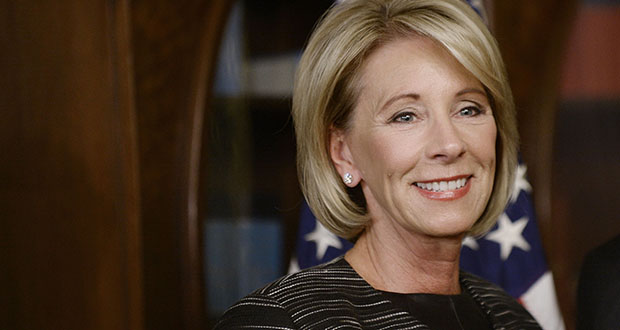
Following Friday’s announcement by the Department of Education that it has rescinded Obama-era guidelines for universities to investigate sexual assault cases for Title IX compliance, schools now have the option to apply a higher burden of proof standard than the currently-used “preoponderance of evidence.” Ohio State is unlikely to make a change unless directed to. Credit: Jack Westerheide | Photo Editor
Despite Friday’s Department of Education announcement which opened the door for universities to change how they handle sexual assault cases on campus, Ohio State is not planning to make a change to its sexual assault policies and procedures anytime soon.
The department rescinded an Obama-era directive — rolled out in 2011 via a Dear Colleague letter — to universities directing them to take accusations more seriously than they had previously and to use a less-stringent evidence standard for determining if students are in violation of sexual misconduct policies. The announcement follows two separate occasions — the first in July, the second earlier in September — when Education Secretary Betsy DeVos said the department was looking to change the policy.
While Friday’s announcement indicated the department is working on a more formal replacement for the former administration’s policy, in the interim it granted universities the freedom to use a higher evidence standard in deciding such cases in place of the lower standard, which Ohio State uses, and which has been required of all public universities since the 2011 policy was enacted.
That lower standard, known as “preponderance of evidence,” means a decision is based on whichever direction more than 50 percent of evidence points toward. Critics of the 2011 policy — including the National Coalition for Men, members of which met with the secretary in July, along with students, parents and school administrators — have called for the more stringent “clear and convincing” standard to be used in order to help avoid wrongfully accused students, who are usually men, from being punished.
The university said Friday it will continue to monitor the Department of Education’s future actions. But, in an interview with The Lantern in July after Devos’ first announcement, Kellie Brennan, the director of compliance and the Title IX and Clery Act coordinator for Ohio State said, changing the standard would create major disparities.
Since all other university compliance cases use the “preponderance of evidence” standard, including cases of theft, academic misconduct and race discrimination, Brennan said changing the standard in one area would be problematic.
“If we were to change and investigate sex discrimination and sexual harassment and sexual assault at a higher standard, what that means is that it’s harder to prove sex discrimination than it is to prove any other thing happened,” Brennan said.
Brennan said she isn’t aware of any institutions that currently use the “clear and convincing” standard, and added she isn’t trained in applying it.
Critics of the “preponderance” standard argue that 51 percent certainty is too low for a decision that can potentially destroy a student’s reputation and halt their education.
Speaking at George Mason University on Sept. 7, DeVos said the 2011 standards have served both sexual assault victims and accused perpetrators badly. She said the disenfranchisement of some wrongfully accused men had driven them to the brink of suicide.
The attention to the issue of sexual assault at universities tends to focus on the investigatory aspect, but that obscures one point, at least at Ohio State: The vast majority of sexual violence complaints are not investigated by the university.
Brennan said 434 student Title IX complaints — categorized as sexual assault, dating violence, stalking, sexual harassment or sexual exploitation — were made at Ohio State in the 2016-17 academic year, and that of those 37 went through a full compliance investigation process to where a decision was made, known as adjudication.
“Most of the people who’ve experienced that kind of a trauma and come forward to the university, they just want help,” Brennan said regarding why so few cases were investigated.
“Most often, they want to be able to go to class, and they want to get some counseling help, and possibly get some assistance with different housing, you know, something that’s going to make them feel safer. Most students are not interested in moving forward to an actual process of investigation,” she said.

Education Secretary Betsy DeVos smiles during a swearing-in ceremony in the Vice President’s Ceremonial Office in the Eisenhower Executive Office Building of the White House on Feb. 7, 2017 in Washington, D.C. Credit: Courtesy Olivier Douliery/Abaca Press/TN
She added that about half of the cases do not even name an accused person, either because the person is unknown or because the victim wishes to keep it confidential. Other times, the accused person is not affiliated with Ohio State. In either situation, there is no student for the university to investigate for noncompliance.
The recommendations issued Friday are temporary until the department concludes its study on what the policy should be, which includes a period of public input that the department skipped prior to the 2011 Dear Colleague letter.
Brennan said even if the current phase of public comment leads to a significant change in Department of Education standards, Ohio State’s handling of Title IX compliance cases has been efficient enough that she doesn’t imagine a change having a huge impact.
“This campus has really made a commitment to this issue and to putting it out front and putting resources toward it,” Brennan said in July. “So whatever changes happen I don’t see influencing the work that we do because the ship has sailed. I mean, the campus cares about this.”
Following Friday’s announcement, The Lantern reached out to the university for an updated comment and received the following emailed statement from Brennan:
“We will continue to monitor developments from the Department of Education and, as always, will adhere to federal guidance. Our university policies were written to achieve gender equity and fairness and create a safe and healthy campus climate for our students and for all members of the university community. Programs like Buckeyes ACT and Buck-I-CARE are part of this ongoing, comprehensive effort to stop sexual misconduct, prevent its recurrence, eliminate any hostile environment, and remedy its discriminatory effects. Ohio State does not tolerate sexual misconduct or discrimination under any circumstances, and that will not change.”
A look at the most recent campus culture survey — released Wednesday — reveals that thousands of students are likely victims of sexual assault at Ohio State. Twenty percent of undergraduate female respondents and 4.6 percent of undergraduate male respondents reported experiencing non-consensual sexual intercourse, sexual touching involving physical force or incapacitation since enrolling.
Sexual assault is a criminal act subject to prosecution and — in a case where an accused person is named or physical evidence is collected by law enforcement — a criminal investigation may additionally run alongside a university investigation.
Student conduct can only investigate a potential conduct violation if the person accused is a student at Ohio State, said Doug Koyle, assistant vice president for The Office of Student Life at Ohio State. If the person accused is a student at the university, the victim has the option of pursuig a code of conduct investigation.
The Office of Student Life receives police reports on sexual misconduct, but does not require anyone to participate in the conduct process, Koyle said.
On the other hand, university agencies who are told of a sexual assault incident — or any suspected felony — are required by Ohio law to report it to law enforcement, though anonymity of all parties can be kept if the person reporting the violation wishes to do so.
“We can actually call and make a third-party report to police so that there’s a record that the university received the information and that there’s a police report number that’s generated,” said Brennan. “And then once the report number is there, we can give that to the victim and then they can call a detective any time up to 20 years later and initiate and talk with a detective about their experience.”
Compliance investigations are unique to each case, but they typically start with an initial report from either the complainant, police or residence hall adviser. Then, statements are taken from any relevant party.
“No one is forced to participate,” Koyle said. “It’s important for us to have a fair and balanced process.”
If the accused student decides not to participate, the investigation continues based on information investigators already have. Those investigators — there are five of them — only handle sexual misconduct investigations, and are the ones who decide whether an investigation moves forward to a hearing.
If the accused is charged with noncompliance the university holds a hearing process with administrators in student conduct, and applies the evidence standard — currently “preponderance of the evidence” — to decide whether or not the student has violated Title IX.
The respondent does not have to be present for the hearing — an email is sent with the outcome using resources that allow for student conduct to know if the email was opened and read, Koyle said.
“The code is something that is reviewed and revised periodically and that’s initiated by the council of student affairs which is a council from senate committee,” Koyle said. “It gives different stakeholders including students to be involved in any potential revisions that need to take place.”
It was last reviewed and revised in 2016.
Summer Cartwright contributed to this article.
Updated: Sept. 29 at 5:13 p.m. to clarify that 37 Title IX complaints made in the 2016-17 academic year were adjudicated, meaning they went through a full compliance investigation and a decision was reached. The previous version of this story said only 37 cases were investigated. All complaints received by the compliance office have a preliminary investigation, though a full compliance investigation is not always launched.


